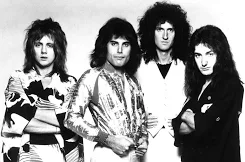“Somebody to Love” by Queen,
https://www.youtube.com/watch?v=kijpcUv-b8M
Released in 1976 on the album A Day at the Races, “Somebody to Love” not only showcases Queen’s gospel-inspired harmonies and Freddie Mercury’s powerful vocals but also delves into the profound themes of loneliness and the universal search for love. The song, a unique blend of rock, soul, and gospel influences, is often lauded for its intricate vocal arrangements and its raw emotional depth.
Freddie Mercury was inspired to write “Somebody to Love” as a heartfelt tribute to Aretha Franklin, the Queen of Soul. Her gospel style and vocal power deeply moved him, and he wanted to channel that same emotional intensity into a Queen song.
Here are the key inspirations behind the track:
- Aretha Franklin’s Gospel Influence: Freddie admired Aretha’s early gospel albums and wanted to emulate that sound. He once said, “I just wanted to write something in that kind of thing. I was incentivized by the gospel approach that she had on her albums.”
- A Gospel Choir Feel: Instead of using an actual choir, Queen layered the voices of Mercury, Brian May, and Roger Taylor to create the effect of a 100-voice gospel choir. This technique was like what they did in “Bohemian Rhapsody,” but with a gospel twist.
- Personal Longing: Lyrically, the song is a poignant reflection of Mercury’s own quest for love and connection. It’s a soul-searching ballad where he candidly questions why he works so hard yet still feels unloved, adding a deeply personal layer to the song’s gospel fervor. This personal touch adds a layer of authenticity and relatability to the music.
Brian May even remarked that “Freddie wanted to be Aretha Franklin” when writing the song, highlighting just how much she influenced his creative direction.
Queen recorded “Somebody to Love” with the same meticulous, layered approach they used for Bohemian Rhapsody, but this time with a gospel twist.
Here’s how the recording process unfolded:
🎹 Composition and Arrangement
- Freddie Mercury wrote the song at the piano, inspired by gospel music and Aretha Franklin.
- He came into the studio with a clear vision, having already mapped out many of the vocal parts.
- The song was structured in sections, allowing the band to build it piece by piece.
🎤 Vocal Layering
- Queen’s unique approach to vocal layering involved multi-tracking the voices of just three members: Freddie Mercury, Brian May, and Roger Taylor. Each Member recorded their vocals multiple times, which were then layered to create the effect of a 100-voice gospel choir. This innovative technique was a key factor in achieving the desired sound, reminiscent of their approach in “Bohemian Rhapsody,” but with a gospel twist.
- They recorded their harmonies repeatedly, layering them to create a massive choral sound.
- John Deacon, the bassist, did not sing on the studio version, though he mimed vocals in live performances.
🎚️ Studio Techniques
- The band used Wessex Sound Studios and Sarm East Studios, pushing the limits of analog recording technology at the time. This involved using advanced recording equipment and techniques to capture the intricate vocal arrangements and the rich, textured sound of Freddie Mercury’s vocals. The use of these studios and recording techniques was crucial in achieving the desired sound for the song.
- Mercury’s vocals were overdubbed multiple times, creating a rich, textured sound.
- The band also used a real piano, played by Mercury, to give the track an intimate, live feel.
🎸 Instrumentation
- Brian May’s guitar solo added a rock edge to the gospel foundation.
- Roger Taylor described the track as “the loosest we’ve ever done,” aiming for a free-flowing gospel feel rather than rigid structure.
📝 Editing and Final Touches
- The song originally had more sections, but some were cut to streamline the final version.
- Despite the complexity, the band kept the emotional core intact, resulting in a track that was both technically impressive and profoundly moving.
The final mix of Queen’s “Somebody to Love” was a masterclass in analog-era studio craftsmanship. Here’s how the band approached mixing this gospel-rock anthem:
🎛️ Mixing Techniques and Challenges
· Vocal Layering as a Choir Substitute:
o Freddie Mercury, Brian May, and Roger Taylor multi-tracked their voices dozens of times to simulate a 100-voice gospel choir.
o These layers were carefully balanced in the mix to create a rich, immersive choral effect without overwhelming the lead vocal.
· Maintaining a Loose, Gospel Feel:
o Roger Taylor described the track as “the loosest we’ve ever done,” and the mix reflects that intention. The engineers avoided over-polishing, allowing the natural dynamics and swing of the performance to shine through.
· Piano and Rhythm Section:
o Freddie’s live piano performance was kept prominent in the mix to preserve the song’s emotional intimacy.
o The rhythm section (bass and drums) was mixed to support the gospel groove without dominating it, giving the track a soulful, church-like pulse.
· Guitar Integration:
o Brian May’s guitar solo and fills were mixed to cut through the dense vocal layers, adding a rock edge while still blending with the gospel vibe.
· Analog Tape and Manual Mixing:
o The song was mixed using analog tape machines, meaning all effects, fades, and balances were done manually.
o Engineers and band members often had to perform real-time mix passes, adjusting faders and EQs live during playback to achieve the desired result.
· Streamlining the Arrangement:
o The original version had more sections, but some were cut during mixing to tighten the structure. These edits helped maintain the song’s emotional arc without losing momentum.
The final mix of Queen’s “Somebody to Love” was a masterclass in analog-era studio craftsmanship. It balanced technical complexity with emotional resonance, making “Somebody to Love” one of Queen’s most beloved and sonically rich recordings.
